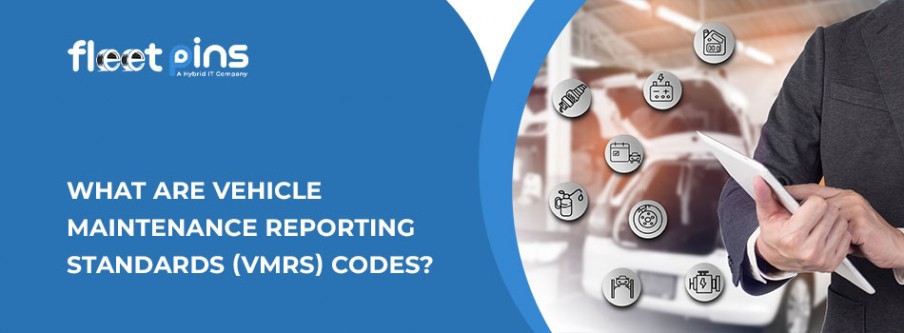
- On 2024-11-08
What are Vehicle Maintenance Reporting Standards (VMRS) Codes?
Vehicle maintenance reporting standards, or VMRS codes, are a standardized system for categorizing and recording maintenance and repair information for vehicles. These codes are primarily used in commercial trucking and the fleet industry. These codes are developed by the Technology and Maintenance Council (TMC) of the American Trucking Association. Infect, VMRS codes enable fleet operators, mechanics, and other industry professionals to systematically track vehicle repairs and maintenance work.
What are VMRS?
VMRS was first introduced in the 1970s to address the need for uniformity in vehicle maintenance documentation. Fleet managers were utilizing different ways to record maintenance information. This led them to inconvenience in analyzing and data sharing. VMRS brings a unified structure, making it easier to record, understand, and keep data across different organizations and systems.
Why are VMRS Codes Important?
VMRS codes are essential for essential fleet management; they provide a common language for:
- Tracking maintenance record
- Analyzing record
- Reduce maintenance cost
- Increase vehicle uptime
- Regulatory compliance
How does VMRS codes work?
These codes are structured using a multi-level numeric system that breaks down vehicle components. Also, breakdown repair work into categories and subcategories and specific codes:
- Component Code (3-digit): The first part identifies the specific vehicle component being worked on, such as brakes, engine, or transmission; for example, “002” could represent brake system.
- System Code (1-digit): This identifies the broader system associated with the component, like “2for electrical or “3” for powerline.
- Assembly code (4-digit): This code provides even more detail, narrowing down to specific assemblies within the component.
- Action code: The action code specifies what action is being taken, such as “repair, replace, and inspect.”.
- Cause Code: This part describes why the work is being done, such as “normal wear” or “accident damage.”.
Examples of common Cods:
- 001-002-000 might represent a brake system inspection
- 006-001-000 donate specific part of the engine’s fuel injection system
- 017-003-001 refers to an air conditioning unit within the vehicle cabin area
You May Also Read: How Dashcams Enhance Driving Safety and Security | Complete Guide
Categories covered by VRMS codes
VRMS codes cover every conceivable part of a vehicle’s anatomy and maintenance activities. Each category ensures comprehensive reporting across all aspects of the vehicle, including:
- Engine system
- Brake system
- Tires and wheels
- Transmission system
- Body component
How Do VMRS Codes Benefit Fleet Management?
VRMS codes provide a structured system for fleet management that offers several important benefits. By streamlining maintenance, tracking, and analysis, VMRS codes support fleet operations in optimizing costs, improving vehicle reliability, and ensuring safety compliance.
Enhanced Maintenance Tracking
These codes standardize how data is recorded, making it easy to track and access repair histories across all vehicles. With WMRS, every repair, replacement, or inspection is categorized. This level of detail ensures no information is overlooked, giving fleet managers a clear understanding of vehicle conditions.
Preventive Maintenance Planning
With a clear maintenance history, fleet managers can proactively address issues before they escalate. This reduces the chance of costly emergency repair. Know more about preventive maintenance and how effective it is for your fleet in “The Benefits of Preventative Maintenance Programs for NEMT Fleets.”
Improved Cost Control
These codes allow fleet managers to analyses which components or systems are costing the most in repairs. This helps them pinpoint potential areas for cost saving. With a clear maintenance history, fleet managers can proactively address issues before they escalate.
Enhanced Safety and Compliance
VMRS codes make it easier to document maintenance history. This ensures the fleet can meet industry safety standards and regulatory requirements. Regular tracking of vehicle maintenance ensures that all components are functioning correctly.
You May Also Read: Benefits of Dash Cams for Fleet Vehicles
How Fleet Management Systems Benefit Your Fleet
Fleet Pins provides a comprehensive fleet management solution that simplifies and optimizes the management of your fleet. The platform includes tools for scheduling routine maintenance, which helps prevent breakdowns and reduces repair costs by keeping vehicles in top condition. Fleet Pins also features GPS tracking and telematics, enabling fleet managers to monitor driver behavior, improve route planning, and identify inefficiencies such as excessive idling or speeding.
Additionally, the system provides detailed reports on vehicle performance, fuel consumption, and overall fleet utilization. This data provides managers with insights needed to make informed decisions. By centralizing all aspects of motor pool management, Fleet Pins helps reduce operational costs, improve vehicle availability, and ensure smoother fleet operations.
Interested in optimizing your fleet performance? Request a demo today for customized solutions that enhance efficiency, safety, and cost savings.




